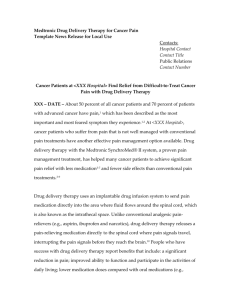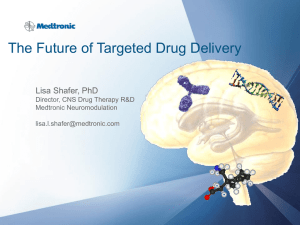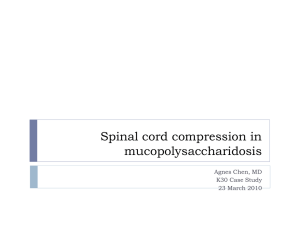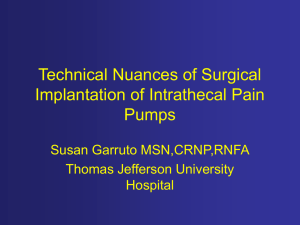Enterra® Neurostimulator Web site Copy
advertisement
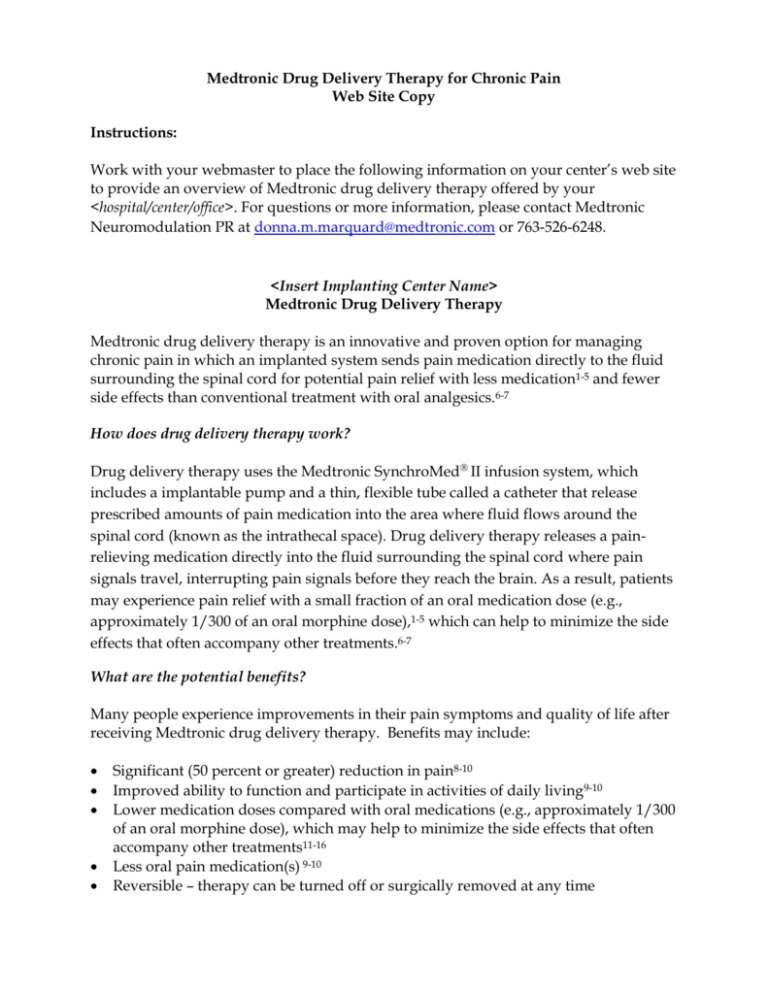
Medtronic Drug Delivery Therapy for Chronic Pain Web Site Copy Instructions: Work with your webmaster to place the following information on your center’s web site to provide an overview of Medtronic drug delivery therapy offered by your <hospital/center/office>. For questions or more information, please contact Medtronic Neuromodulation PR at donna.m.marquard@medtronic.com or 763-526-6248. <Insert Implanting Center Name> Medtronic Drug Delivery Therapy Medtronic drug delivery therapy is an innovative and proven option for managing chronic pain in which an implanted system sends pain medication directly to the fluid surrounding the spinal cord for potential pain relief with less medication1-5 and fewer side effects than conventional treatment with oral analgesics.6-7 How does drug delivery therapy work? Drug delivery therapy uses the Medtronic SynchroMed II infusion system, which includes a implantable pump and a thin, flexible tube called a catheter that release prescribed amounts of pain medication into the area where fluid flows around the spinal cord (known as the intrathecal space). Drug delivery therapy releases a painrelieving medication directly into the fluid surrounding the spinal cord where pain signals travel, interrupting pain signals before they reach the brain. As a result, patients may experience pain relief with a small fraction of an oral medication dose (e.g., approximately 1/300 of an oral morphine dose),1-5 which can help to minimize the side effects that often accompany other treatments.6-7 What are the potential benefits? Many people experience improvements in their pain symptoms and quality of life after receiving Medtronic drug delivery therapy. Benefits may include: Significant (50 percent or greater) reduction in pain8-10 Improved ability to function and participate in activities of daily living9-10 Lower medication doses compared with oral medications (e.g., approximately 1/300 of an oral morphine dose), which may help to minimize the side effects that often accompany other treatments11-16 Less oral pain medication(s) 9-10 Reversible – therapy can be turned off or surgically removed at any time Only Medtronic offers a programmable drug delivery system that is FDA approved for MRI scans* that resumes programmed therapy after the scan. **Under specific conditions of use. Talk to your doctor. What conditions are treated with Medtronic drug delivery therapy? Since the first implantable drug pump was approved for the treatment of chronic pain 20 years ago, drug delivery therapy has been used to treat chronic pain in thousands of patients with the following conditions:17 Cancer pain Chronic back and leg pain Complex Regional Pain Syndrome (CRPS) Painful neuropathy Is Medtronic drug delivery therapy right for me? The treatment option that will work best for you depends on your type of pain, how severe it is, and how you respond to pain treatment. It might be right for you if:18 Other treatment options haven’t provided pain relief or have produced uncomfortable side effects Further surgeries are not recommended You don’t have a serious, untreated dependence on pain medication You don’t have medical issues that would make surgery difficult You have had a successful drug delivery screening test To learn more about Medtronic intrathecal drug delivery therapy, contact <insert appropriate phone and/or web site contact information> or visit www.tamethepain.com. References 1. North R, Kidd D, Zuhurak M, et al. Spinal Cord Stimulation for Chronic, Intractable Pain: Experience Over Two Decades. Neurosurgery 1993;32 384-395. 2. Kumar K, Toth C, Nath R, et al. Epidural Spinal Cord Stimulation for Treatment of Chronic Pain – Some Predictors of Success. A 15-Year Experience. Surg Neurol 1998;50:110-121. 3. De La Porte C, Van de Kelft E. Spinal Cord Stimulation in Failed Back Surgery Syndrome. Pain 1993;52:55-61. 4. Devulder J, De Laat M, Van Bastalaere M, et al. Spinal Cord Stimulation: A Valuable Treatment for Chronic Failed Back Surgery Patients. J Pain Symptom Manage 1997;13:296-301. 5. Burchiel K, Anderson V, et al. Prospective, Multicenter Study of Spinal Cord Stimulation for Relief of Chronic Back and Extremity Pain. Spine 1996;21:2786-2794. 6. Lamer TJ. Treatment of cancer-related pain: When orally administered medications fail. Mayo Clinical Proc 1994;69:473-80. 7. Levy, R. Implanted Drug Delivery Systems for Control of Chronic Pain. Chapter 19 of Neurosurgical Management of Pain. New York, NY: Springer-Verlag; 1997. 8. Doleys DM, Brown JL, Ness T. Multidimensional outcomes analysis of intrathecal, oral opioid and behavioral functional restoration therapy for failed back surgery syndrome: a retrospective study with 4 years’ follow-up. Neuromodulation. 2006;9:270-283. 9. Deer T, Chapple I, Classen A, et al. Intrathecal drug delivery for treatment of chronic low back pain: report from the National Outcomes Registry for Low Back Pain. Pain Med. 2004;5:6-13. 10. Roberts LJ, Finch PM, Goucke CR, Price LM. Outcome of intrathecal opioids in chronic non-cancer pain. Eur J Pain. 2001;5:353-361. 11. Brogan SE. Intrathecal therapy for the management of cancer pain. Curr Pain Headache Rep. 2006;10:254-259. 12. Gerber HR. Intrathecal morphine for chronic benign pain. Best Pract Res Clin Anaesthesiol. 2003;17:429-442. 13. Nance P, Meythaler J. Intrathecal drug therapy. Phys Med Rehabil Clin N Am. 1999;10:385-401, viii-ix. 14. Ruan X. Drug-related side effects of long-term intrathecal morphine therapy. Pain Physician. 2007;10:357-366. 15. Smith TJ, Swainey C, Coyne PJ. Pain management, including intrathecal pumps. Curr Pain Headache Rep. 2005;9:243-248. 16. Winkelmüller M, Winkelmüller W. Long-term effects of continuous intrathecal opioid treatment of chronic pain of nonmalignant etiology. J Neurosurg. 1996;85:458-467. 17. Link: http://www.medtronic.com/our-therapies/index.htm. Accessed: January 12, 2011. 18. Medtronic information on file. Important Safety Information SynchroMed® II Drug Infusion System Brief Summary: Product technical manuals and the appropriate drug labeling must be reviewed prior to use for detailed disclosure. Indications: US: Chronic intraspinal (epidural and intrathecal) infusion of preservative-free morphine sulfate sterile solution in the treatment of chronic intractable pain, chronic intrathecal infusion of preservative-free ziconotide sterile solution for the management of severe chronic pain, and chronic intrathecal infusion of Lioresal™ Intrathecal (baclofen injection) for the management of severe spasticity; chronic intravascular infusion of floxuridine (FUDR) or methotrexate for the treatment of primary or metastatic cancer. Outside of US: Chronic infusion of drugs or fluids tested as compatible and listed in the product labeling. Contraindications: Infection; implant depth greater than 2.5 cm below skin; insufficient body size; spinal anomalies; drugs with preservatives, drug contraindications, drug formulations with pH ≤3, use of catheter access port (CAP) kit for refills or of refill kit for catheter access, blood sampling through CAP in vascular applications, use of Personal Therapy Manager to administer opioid to opioid-naïve patients or to administer ziconotide. Warnings: Non-indicated formulations may contain neurotoxic preservatives, antimicrobials, or antioxidants, or may be incompatible with and damage the system. Failure to comply with all product instructions, including use of drugs or fluids not indicated for use with system, or of questionable sterility or quality, or use of non-Medtronic components or inappropriate kits, can result in improper use, technical errors, increased risks to patient, tissue damage, damage to the system requiring revision or replacement, and/or change in therapy, and may result in additional surgical procedures, a return of underlying symptoms, and/or a clinically significant or fatal drug under- or overdose. Refer to appropriate drug labeling for indications, contraindications, warnings, precautions, dosage and administration information, screening procedures and underdose and overdose symptoms and methods of management. Physicians must be familiar with the drug stability information in the product technical manuals and must understand the dose relationship to drug concentration and pump flow rate before prescribing pump infusion. Implantation and ongoing system management must be performed by individuals trained in the operation and handling of the infusion system. An inflammatory mass that can result in serious neurological impairment, including paralysis, may occur at the tip of the implanted catheter. Clinicians should monitor patients on intraspinal therapy carefully for any new neurological signs or symptoms, change in underlying symptoms, or need for rapid dose escalation. Inform patients of the signs and symptoms of drug under- or overdose, appropriate drug warnings and precautions regarding drug interactions, potential side effects, and signs and symptoms that require medical attention, including prodromal signs and symptoms of inflammatory mass. Failure to recognize signs and symptoms and seek appropriate medical intervention can result in serious injury or death. Instruct patients to notify their healthcare professionals of the implanted pump before medical tests/procedures, to return for refills at prescribed times, to carry their Medtronic device identification card, to avoid manipulating the pump through the skin, to consult with their clinician if the pump alarms and before traveling or engaging in activities that can stress the infusion system or involve pressure or temperature changes. Strong sources of electromagnetic interference (EMI), such as short wave (RF) diathermy and MRI, can negatively interact with the pump and cause heating of the implanted pump, system damage, or changes in pump operation or flow rate, that can result in patient injury from tissue heating, additional surgical procedures, a return of underlying symptoms, and/or a clinically significant or fatal drug underdose or overdose. Avoid using shortwave (RF) diathermy within 30 cm of the pump or catheter. Effects of other types of diathermy (microwave, ultrasonic, etc.) on the pump are unknown. Drug infusion is suspended during MRI; for patients who can not safely tolerate suspension, use alternative drug delivery method during MRI. Patients receiving intrathecal baclofen therapy are at higher risk for adverse events, as baclofen withdrawal can lead to a life threatening condition if not treated promptly and effectively. Confirm pump status before and after MRI. Reference product labeling for information on sources of EMI, effects on patient and system, and steps to reduce risks from EMI. Precautions: Monitor patients after device or catheter replacement for signs of underdose/overdose. Infuse preservative-free (intraspinal) saline or, for vascular applications, infuse heparinized solutions therapy at minimum flow rate if therapy is discontinued for an extended period of time to avoid system damage. EMI may interfere with programmer telemetry during pump programming sessions. EMI from the SynchroMed programmer may interfere with other active implanted devices (e.g., pacemaker, defibrillator, neurostimulator). Adverse Events: Include, but are not limited to, spinal/vascular procedure risks; infection; bleeding; tissue damage, damage to the system or loss of, or change in, therapy that may result in additional surgical procedures, a return of underlying symptoms, and/or a clinically significant or fatal drug underdose or overdose, due to end of device service life, failure of the catheter, pump or other system component, pump inversion, technical/programming errors, or improper use, including use of non-indicated formulations and/or not using drugs or system in accordance with labeling; pocket seroma, hematoma, erosion, infection; post-lumbar puncture (spinal headache); CSF leak and rare central nervous system pressure-related problems; hygroma; radiculitis; arachnoiditis; spinal cord bleeding/damage; meningitis; neurological impairment (including paralysis) due to inflammatory mass; potential serious adverse effects from catheter fragments in intrathecal space, including potential to compromise antibiotic effectiveness for CSF infection; anesthesia complications; body rejection phenomena; local and systemic drug toxicity and related side effects; potential serious adverse effects from catheter placement in intravascular applications. USA Rx Only Rev 0311 ###
